Don't wanna be here? Send us removal request.
Text













BARCO VAZIO
Costume Design for the music video "Barco Vazio", by Anda Pacheco, including a made-to-measure dress for the artist.
Mariana (also known as Anda Pacheco) is wearing a custom-made dress, of transparent black chiffon and black lace, over an also custom-made bias cut slip dress.
This dress comes from the wish to honour the wives of the fishermen, and their tradition of wearing full black when it was time to wait for their loved ones' return, after another trip to the sea, off the portuguese coast. It was thought to balance both the traditional and modest costumes of the fishwives, and a more contemporary reinterpretation. The super fitted cut, open back and sheer fabrics in contrast woth the floor length, long sleeves and turtleneck - like a game of hide and seek!
The remaining costumes gather references from several fishing communities in Portugal, past and present, as well as from traditional Portuguese costumes. The checkered mix and match is, for example, the typical wear of the fishermen of Nazaré.
Barco Vazio, de Anda Pacheco.
Costume design: Sofia Videira Pinto.
Director: Tiago Pimentel; Executive Production: Leonor Coelho and Velvet Station; DOP: Fábio Mota; Hair and Makeup: Ana Santos; VFX: Johnny Rodrigues and Indigent Studio.
Pictures: Tomás Monteiro and André Satchel.
0 notes
Text












BARCO VAZIO
Costume Design for the music video "Barco Vazio", by Anda Pacheco, including a made-to-measure dress for the artist.
A little behind the scenes from my studio, and a closer look at the dress I created for Anda Pacheco :)
About the dress:
Mariana (also known as Anda Pacheco) is wearing a custom-made dress, of transparent black chiffon and black lace, over an also custom-made bias cut slip dress.
This dress comes from the wish to honour the wives of the fishermen, and their tradition of wearing full black when it was time to wait for their loved ones' return, after another trip to the sea, off the portuguese coast. It was thought to balance both the traditional and modest costumes of the fishwives, and a more contemporary reinterpretation. The super fitted cut, open back and sheer fabrics in contrast woth the floor length, long sleeves and turtleneck - like a game of hide and seek!
The remaining costumes gather references from several fishing communities in Portugal, past and present, as well as from traditional Portuguese costumes. The checkered mix and match is, for example, the typical wear of the fishermen of Nazaré.
0 notes
Text












PARÁBOLA, BY SANDRA HUNG
COSTUMES FOR THEATRE.
Design and making of 12 costumes for the theatre play Parábola, by Sandra Hung, performed by Novo Núcleo Teatro, in Almada.
Design e confecção de 12 figurinos para a peça de teatro Parábola, de Sandra Hung, com performance do Novo Núcleo Teatro, em Almada.
EN
Novo Núcleo Teatro challenged me to create the costumes for their next play, using an unusual donation of hospital scrubs. The tricky part was… the play was not at all related to hospitals, doctors or patients. Parábola is an energetic play that explores the behaviour of two opposed groups around a common element of desire, in hectic and intriguing choreographies. Due to the nature of the play, the costumes had to be adapted to allow for freedom of movement, and safe for stage falls and floor manoeuvres. The two existing groups became distinguishable through colour, bringing individuality within the common ground.
Parábola won the FATAL 2024 award for best theatre play.
PT
O Novo Núcleo teatro desafiou-me a criar os figurinos para a sua próxima peça, usando uma doação pouco usual de fatos de hospital. A parte mais curiosa era… que a peça não envolve de todo hospitais, médicos ou pacientes. Parábola é uma peça energética que explora o comportamento de dois grupos opostos em torno de um objeto de desejo, em coreografias frenéticas e intrigantes. Devido à natureza da peça, os figurinos tiveram de ser adaptados de modo a permitir liberdade de movimentos e a serem seguros para as quedas em cena e manobras no chão. Através da cor, fez-se a distinção entre os dois grupos, e através dos detalhes o toque de individualidade de cada elemento, no meio da trivialidade.
Parábola venceu o prémio FATAL 2024 para melhor peça de teatro.
Fotografias: Marta Tavares
Figurinos: Sofia Videira Pinto
0 notes
Text
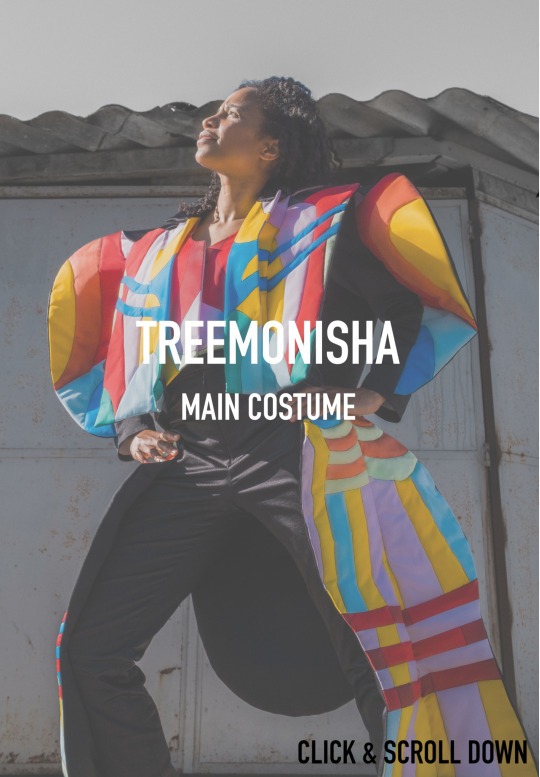
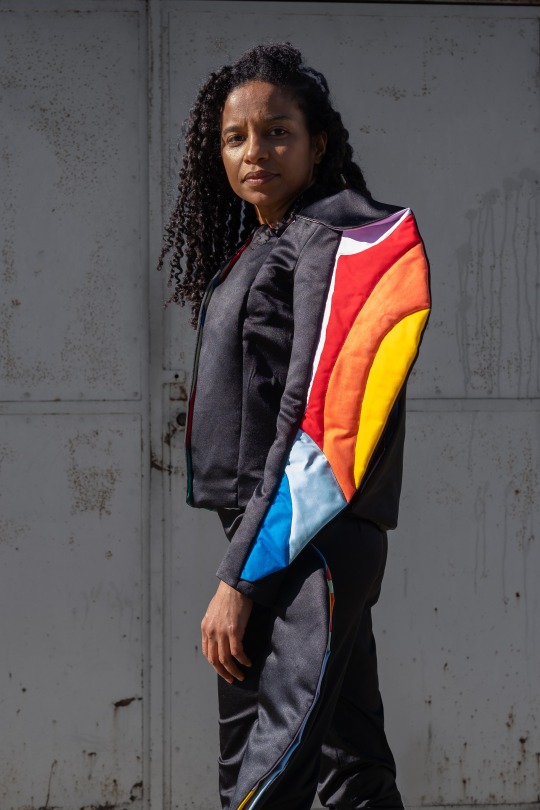
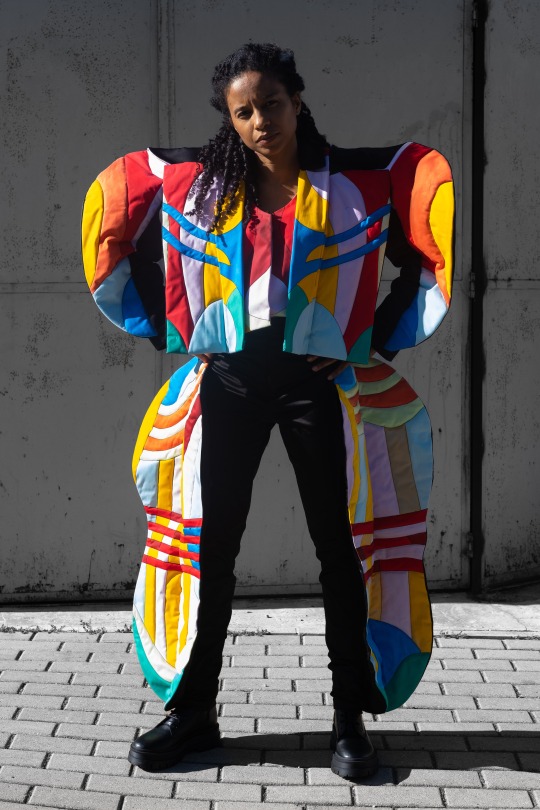
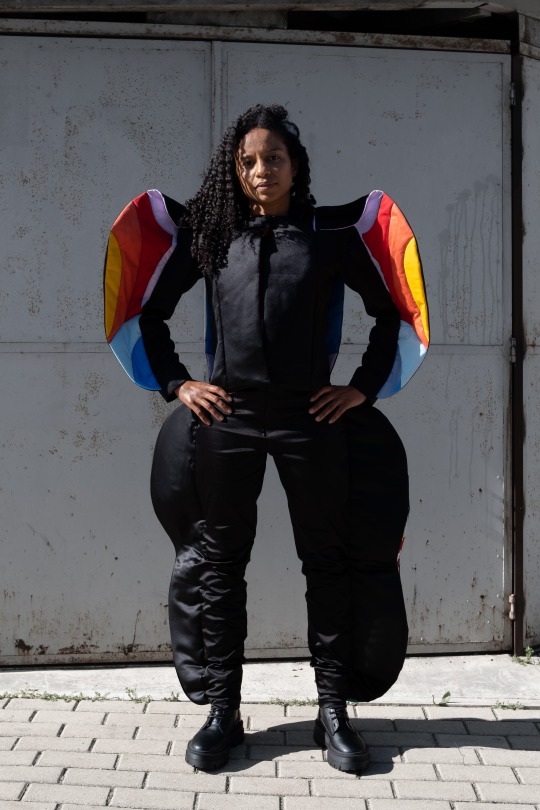
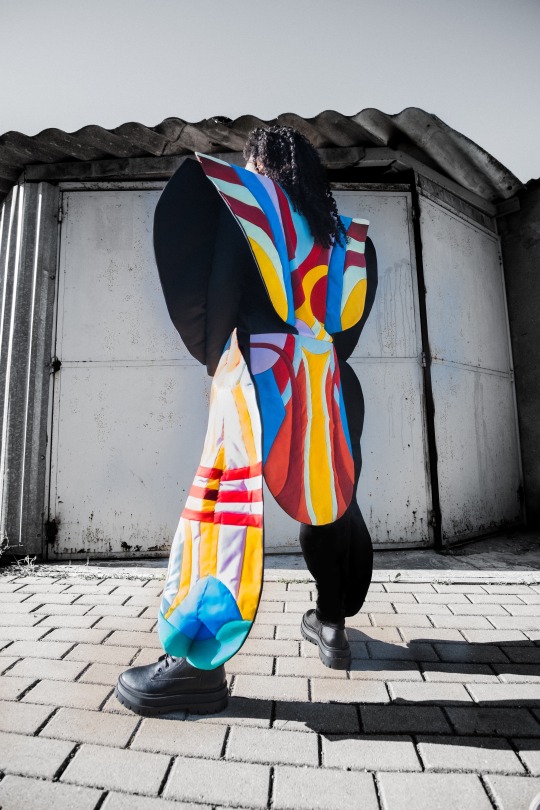
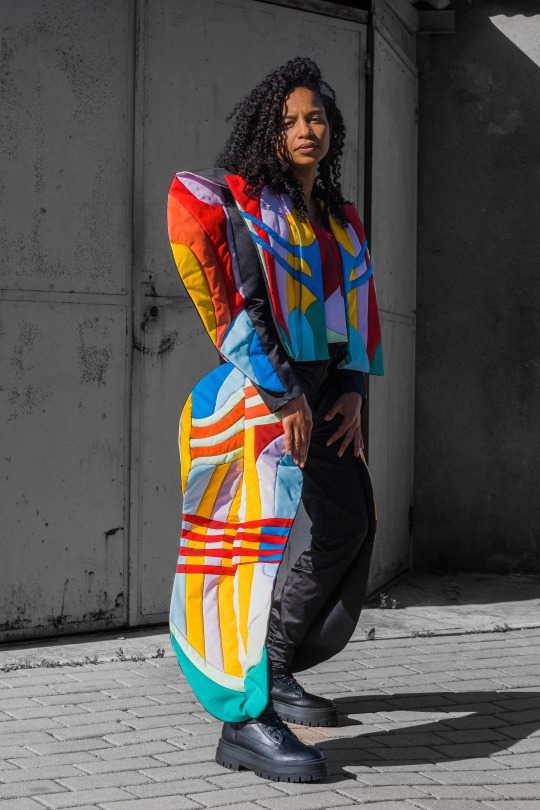
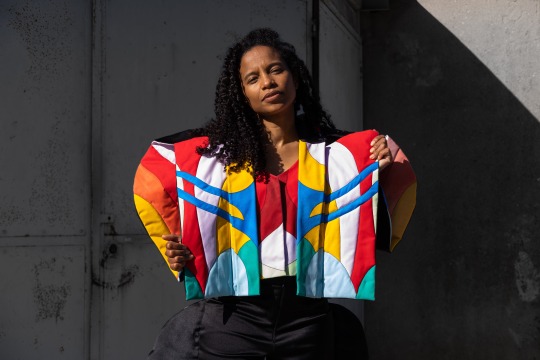
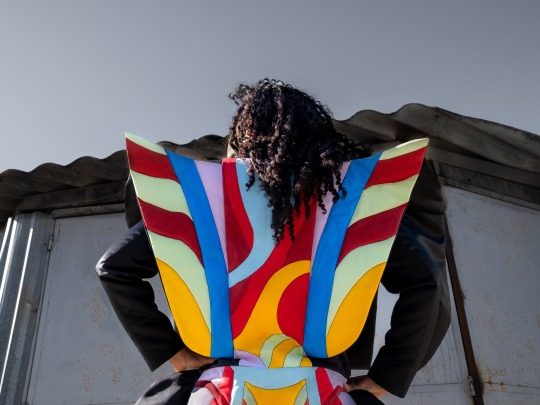
TREEMONISHA, BY SCOTT JOPLIN
COSTUME DESIGN FOR OPERA ADAPTATION.
Costume for Treemonisha, designed and made by Sofia Videira Pinto. Cotton and satin. The costume is hand-painted, quilted, and through the use of hidden magnets, it changes in three acts, every time revealing more colour. Figurino para Treemonisha, desenhado e confecionado por Sofia Videira Pinto. Cetim e algodão. O figurino é pintado à mão, acolchoado e, através do uso de ímanes, muda em três atos, sempre revelando um pouco mais de cor.
EN
Costume project for my adaptation of the 1911 opera Treemonisha.
Originally taking place in rural postbellum Arkansas, in the 1880s, a clever African-American young woman, called Treemonisha, is elected the leader of her community of sharecroppers, after showing how superstition is the enemy of progress and knowledge and education constitute the brighter way forward.
My adaptation, though, places Treemonisha in a different time and setting: in the Auto City of Detroit, during the late 1920s, after the Great Migration that led farmer communities of the south finding their way north. Treemonisha is inspired by the first African-American female pilot, Bessie Coleman, and she is herself a pioneer and a pilot. Her family and friends are mechanics and factory workers, and the dark aura of superstition is perpetuated by Zodzetrick, a vicious sorcerer. Soon enough though, Treemonisha will prove the values of an open and innovative mind to her peers, and bring music, life and colour to the ones around her.
The concept behind the costumes is the one of emerging colours through the darkness. Starting mainly black, the costumes open panels each new act, that reveal bright and lively hues. By the end of the opera, the costumes evoke a victorious festival of colour. The garments and panels are hand painted and quilted, as an homage to the African-American tradition of quilting, which played an important role in the freedom and emancipation of former slaves. The sleeves and back of the jacket, as well as the trousers, resemble the shape of an aeroplane and wings, honouring both Bessie Coleman and Treemonisha as pioneers and messengers of hope; the front of the jacket resembles a book, an ode to the importance of education within the communities.
PT
Projeto de figurinos para uma adaptação própria da ópera Treemonisha, de 1911.
Originalmente a peça toma lugar numa aldeia rural de Arkansas, após a guerra civil americana, nos anos 1880, onde uma jovem Afro-Americana corajosa e inteligente, Treemonisha, é eleita líder da sua comunidade de meeiros, depois de demonstrar como a superstição é inimiga do progresso, e a educação de todos é o caminho mais luminoso para o futuro.
Na minha adaptação, no entanto, a história desenvolve-se na cidade de Detroit (The Auto City), nos tardios anos 20, depois da Grande Migração que levou comunidades de agricultores do sul dos EUA a rumar a norte. Treemonisha é inspirada na primeira piloto Afro-Americana, Bessie Coleman, sendo ela também uma pioneira, tanto na aviação, como nos seus ideais. A sua família e amigos são, nesta adaptação, mecânicos e trabalhadores de fábricas, e a aura pesada e negra da superstição é perpetuada por Zodzetrick, um feiticeiro vicioso. No entanto, em breve, Treemonisha vai provar os valores de uma mente aberta e inovadora à sua comunidade, e trazer música e cor às suas vidas.
O conceito por trás dos figurinos tem por base as cores vivas que emergem pela escuridão. Se ao ínicio se apresentam fundamentalmente negros, os vários figurinos vão ao longo dos atos revelando novos painéis de cores vivas e vibrantes. No final da ópera, os figurinos evocam um vitorioso festival de cor. Todas as peças e painéis foram feitos e pintados à mão, e usando técnicas de quilting (colcha), em homenagem a esta tradição Afro-Americana, que teve um papel importante na libertação e emancipação de antigos escravos. As mangas e as costas do casaco, bem como as calças, são inspiradas em formas alares e de aviões, homenageando Bessie Coleman e Treemonisha, pioneiras e mensageiras de esperança; a frente do casaco assemelha-se a um livro, numa ode à importância da educação nas comunidades.
Fotografias: Sebastião Ogando
Modelo: Belinha Zêgo
Figurinos: Sofia Videira Pinto
1 note
·
View note
Photo






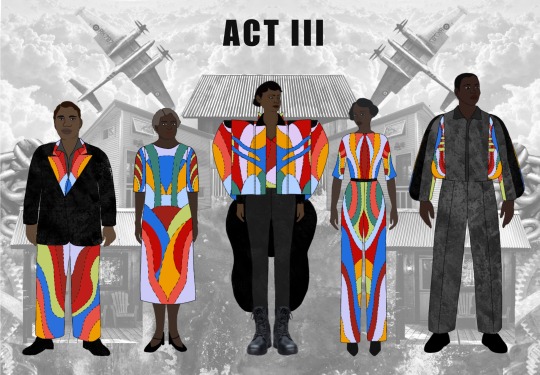
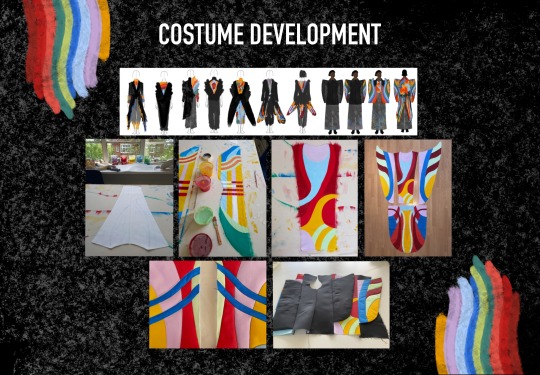
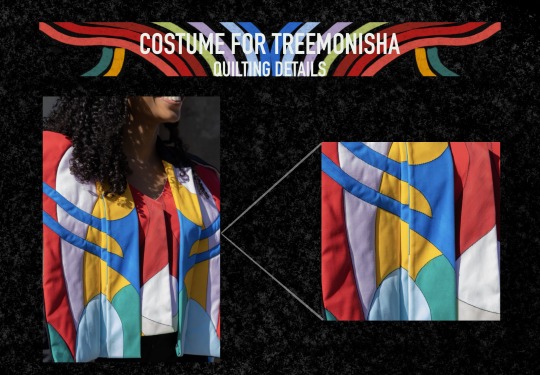
TREEMONISHA, BY SCOTT JOPLIN.
COSTUME DESIGNS.
Costume designs for Treemonisha and the other characters, and their progression through the acts. Design development and details.
Figurinos para Treemonisha e restantes personagem, e progressão ao longo dos atos. Desenvolvimento de design e detalhes.
EN
Costume project for my adaptation of the 1911 opera Treemonisha.
Originally taking place in rural postbellum Arkansas, in the 1880s, a clever African-American young woman, called Treemonisha, is elected the leader of her community of sharecroppers, after showing how superstition is the enemy of progress and knowledge and education constitute the brighter way forward.
My adaptation, though, places Treemonisha in a different time and setting: in the Auto City of Detroit, during the late 1920s, after the Great Migration that led farmer communities of the south finding their way north. Treemonisha is inspired by the first African-American female pilot, Bessie Coleman, and she is herself a pioneer and a pilot. Her family and friends are mechanics and factory workers, and the dark aura of superstition is perpetuated by Zodzetrick, a vicious sorcerer. Soon enough though, Treemonisha will prove the values of an open and innovative mind to her peers, and bring music, life and colour to the ones around her.
The concept behind the costumes is the one of emerging colours through the darkness. Starting mainly black, the costumes open panels each new act, that reveal bright and lively hues. By the end of the opera, the costumes evoke a victorious festival of colour. The garments and panels are hand painted and quilted, as an homage to the African-American tradition of quilting, which played an important role in the freedom and emancipation of former slaves.
PT
Projeto de figurinos para uma adaptação própria da ópera Treemonisha, de 1911.
Originalmente a peça toma lugar numa aldeia rural de Arkansas, após a guerra civil americana, nos anos 1880, onde uma jovem Afro-Americana corajosa e inteligente, Treemonisha, é eleita líder da sua comunidade de meeiros, depois de demonstrar como a superstição é inimiga do progresso, e a educação de todos é o caminho mais luminoso para o futuro.
Na minha adaptação, no entanto, a história desenvolve-se na cidade de Detroit (The Auto City), nos tardios anos 20, depois da Grande Migração que levou comunidades de agricultores do sul dos EUA a rumar a norte. Treemonisha é inspirada na primeira piloto Afro-Americana, Bessie Coleman, sendo ela também uma pioneira, tanto na aviação, como nos seus ideais. A sua família e amigos são, nesta adaptação, mecânicos e trabalhadores de fábricas, e a aura pesada e negra da superstição é perpetuada por Zodzetrick, um feiticeiro vicioso. No entanto, em breve, Treemonisha vai provar os valores de uma mente aberta e inovadora à sua comunidade, e trazer música e cor às suas vidas.
O conceito por trás dos figurinos tem por base as cores vivas que emergem pela escuridão. Se ao ínicio se apresentam fundamentalmente negros, os vários figurinos vão ao longo dos atos revelando novos painéis de cores vivas e vibrantes. No final da ópera, os figurinos evocam um vitorioso festival de cor. Todas as peças e painéis foram feitos e pintados à mão, e usando técnicas de quilting (colcha), em homenagem a esta tradição Afro-Americana, que teve um papel importante na libertação e emancipação de antigos escravos.
2 notes
·
View notes
Photo





TREEMONISHA, BY SCOTT JOPLIN.
WORLD BOARDS.
Digital art visual boards representing the locations, sets and moods of the opera, as well as the characters of Treemonisha and her peers.
Arte digital representando os locais, cenários e sensações da ópera, bem como a personalidade de Treemonisha e de seus pares.
EN
Costume project for my adaptation of the 1911 opera Treemonisha.
Originally taking place in rural postbellum Arkansas, in the 1880s, a clever African-American young woman, called Treemonisha, is elected the leader of her community of sharecroppers, after showing how superstition is the enemy of progress and knowledge and education constitute the brighter way forward.
My adaptation, though, places Treemonisha in a different time and setting: in the Auto City of Detroit, during the late 1920s, after the Great Migration that led farmer communities of the south finding their way north. Treemonisha is inspired by the first African-American female pilot, Bessie Coleman, and she is herself a pioneer and a pilot. Her family and friends are mechanics and factory workers, and the dark aura of superstition is perpetuated by Zodzetrick, a vicious sorcerer. Soon enough though, Treemonisha will prove the values of an open and innovative mind to her peers, and bring music, life and colour to the ones around her.
The concept behind the costumes is the one of emerging colours through the darkness. Starting mainly black, the costumes open panels each new act, that reveal bright and lively hues. By the end of the opera, the costumes evoke a victorious festival of colour. The garments and panels are hand painted and quilted, as an homage to the African-American tradition of quilting, which played an important role in the freedom and emancipation of former slaves.
PT
Projeto de figurinos para uma adaptação própria da ópera Treemonisha, de 1911.
Originalmente a peça toma lugar numa aldeia rural de Arkansas, após a guerra civil americana, nos anos 1880, onde uma jovem Afro-Americana corajosa e inteligente, Treemonisha, é eleita líder da sua comunidade de meeiros, depois de demonstrar como a superstição é inimiga do progresso, e a educação de todos é o caminho mais luminoso para o futuro.
Na minha adaptação, no entanto, a história desenvolve-se na cidade de Detroit (The Auto City), nos tardios anos 20, depois da Grande Migração que levou comunidades de agricultores do sul dos EUA a rumar a norte. Treemonisha é inspirada na primeira piloto Afro-Americana, Bessie Coleman, sendo ela também uma pioneira, tanto na aviação, como nos seus ideais. A sua família e amigos são, nesta adaptação, mecânicos e trabalhadores de fábricas, e a aura pesada e negra da superstição é perpetuada por Zodzetrick, um feiticeiro vicioso. No entanto, em breve, Treemonisha vai provar os valores de uma mente aberta e inovadora à sua comunidade, e trazer música e cor às suas vidas.
O conceito por trás dos figurinos tem por base as cores vivas que emergem pela escuridão. Se ao ínicio se apresentam fundamentalmente negros, os vários figurinos vão ao longo dos atos revelando novos painéis de cores vivas e vibrantes. No final da ópera, os figurinos evocam um vitorioso festival de cor. Todas as peças e painéis foram feitos e pintados à mão, e usando técnicas de quilting (colcha), em homenagem a esta tradição Afro-Americana, que teve um papel importante na libertação e emancipação de antigos escravos.
1 note
·
View note
Photo








NEOWISE COLLECTION
PHOTOSHOOTS.
Costume design and making: Sofia Videira Pinto. Photos by: Sara Horta; @ritawastaken; Sofia Videira Pinto.
Design e figurinos: Sofia Videira Pinto. Fotografias: Sara Horta; @ritawastaken; Sofia Videira Pinto.
EN
NEOWISE is a collection that seeks its inspiration in the film Blade Runner (Ridley Scott, 1982) and explores the use of technology and its visuals in the design process.
Just like in Blade Runner, NEOWISE explores a futuristic and decadent society, where overconsumption led to a world of oppression, and excessive technology is hindering one’s identity and sense of individual. In order to conquer one’s freedom back, it’s imperative to find ways to disrupt the programming, and reinvent oneself through a new light pattern. In NEOWISE, light is key, and each character rebels against the normative system by implementing different light and colour games on their anonymous masked catsuits.
In the making of this collection, I designed technological patterns which where printed on Lycra to create the catsuits and masks that undisclosed the identity of the character. Each suit either has a different light circuit sewn to it, or is crossed by different coloured LED wires, which constitute the weapon to showcase the individuals personality, that no longer has to hide beneath. The oversized outerwear made of transparent and reflective materials adds to the uniqueness of each costume, as with the movement, light will be reflected always in a different way.
The last key point of this collection is the reuse of technological waste, such as old electrical wires, that served as filling for the puffer jacket and the puffer skirt. All the samples and experimentations with fabric and materials were also made using old objects and scraps.
PT
NEOWISE é uma coleção que procura inspiração no filme Blade Runner (Ridley Scott, 1982) e explora o uso de tecnologia e a sua estética no processo de design.
Tal como em Blade Runner, NEOWISE explora uma sociedade futurista e decadente onde o consumo excessivo conduziu a um mundo de opressão, e a superabundância de tecnologia esconde a identidade e individualidade de cada um. De forma a reconquista a liberdade, é imperativo que cada membro da sociedade encontre formas de romper com a realidade programada e se reinvente através de novos padrões de luz, únicos a cada indivíduo. Em NEOWISE, a luz é a chave, e cada elemento se revolta contra o sistema normativo ao implementar diferentes luzes e jogos de cores nos seus uniformes anónimos.
No processo desta coleção, desenhei vários padrões tecnológicos que foram posteriormente sublimados em Lycra, para criar os fatos e as máscaras que omitem a identidade de cada indivíduo. Cada fato tem costurado um circuito de luz diferente, ou é atravessado por fios LED de cores diferentes, que constituem a chave para demonstrar a sua própria individualidade, que não tem mais de se esconder por dentro. As peças volumosas exteriores, confeccionadas com materiais transparentes e refletores, contribuem para a singularidade de cada figurino, uma vez que com o movimento, a luz é refletida sempre de uma forma diferente.
O último ponto-chave da coleção, é a reutilização de desperdício tecnológico, tal como fios elétricos velhos, que servem agora de preenchimento para o casaco e a saia puffer. Todas as amostras e experiências com tecidos e materiais foram também conseguidas através do uso de objetos em desuso e retalhos.
0 notes
Photo








NEOWISE COLLECTION
PROJECT.
Design project: vision boards and costume designs, in mixed media techniques.
Projeto de design: moodboards e design de figurinos, em técnicas de desenho mistas.
EN
NEOWISE is a collection that seeks its inspiration in the film Blade Runner (Ridley Scott, 1982) and explores the use of technology and its visuals in the design process.
Just like in Blade Runner, NEOWISE explores a futuristic and decadent society, where overconsumption led to a world of oppression, and excessive technology is hindering one’s identity and sense of individual. In order to conquer one’s freedom back, it’s imperative to find ways to disrupt the programming, and reinvent oneself through a new light pattern. In NEOWISE, light is key, and each character rebels against the normative system by implementing different light and colour games on their anonymous masked catsuits.
In the making of this collection, I designed technological patterns which where printed on Lycra to create the catsuits and masks that undisclosed the identity of the character. Each suit either has a different light circuit sewn to it, or is crossed by different coloured LED wires, which constitute the weapon to showcase the individuals personality, that no longer has to hide beneath. The oversized outerwear made of transparent and reflective materials adds to the uniqueness of each costume, as with the movement, light will be reflected always in a different way.
The last key point of this collection is the reuse of technological waste, such as old electrical wires, that served as filling for the puffer jacket and the puffer skirt. All the samples and experimentations with fabric and materials were also made using old objects and scraps.
PT
NEOWISE é uma coleção que procura inspiração no filme Blade Runner (Ridley Scott, 1982) e explora o uso de tecnologia e a sua estética no processo de design.
Tal como em Blade Runner, NEOWISE explora uma sociedade futurista e decadente onde o consumo excessivo conduziu a um mundo de opressão, e a superabundância de tecnologia esconde a identidade e individualidade de cada um. De forma a reconquista a liberdade, é imperativo que cada membro da sociedade encontre formas de romper com a realidade programada e se reinvente através de novos padrões de luz, únicos a cada indivíduo. Em NEOWISE, a luz é a chave, e cada elemento se revolta contra o sistema normativo ao implementar diferentes luzes e jogos de cores nos seus uniformes anónimos.
No processo desta coleção, desenhei vários padrões tecnológicos que foram posteriormente sublimados em Lycra, para criar os fatos e as máscaras que omitem a identidade de cada indivíduo. Cada fato tem costurado um circuito de luz diferente, ou é atravessado por fios LED de cores diferentes, que constituem a chave para demonstrar a sua própria individualidade, que não tem mais de se esconder por dentro. As peças volumosas exteriores, confeccionadas com materiais transparentes e refletores, contribuem para a singularidade de cada figurino, uma vez que com o movimento, a luz é refletida sempre de uma forma diferente.
O último ponto-chave da coleção, é a reutilização de desperdício tecnológico, tal como fios elétricos velhos, que servem agora de preenchimento para o casaco e a saia puffer. Todas as amostras e experiências com tecidos e materiais foram também conseguidas através do uso de objetos em desuso e retalhos.
0 notes
Photo










WHITE COLOUR BLACK
STYLING PROJECT FOR FILM.
Sourcing of costumes for the 3 main characters of the contemporary film, at several different scenes.
Sourcing de peças de roupa contemporâneas para os figurinos das 3 personagens principais do filme, em diversas cenas.
EN
Costume design and styling project proposal for the script of White Colour Black (2016), by Joseph Adesunloye.
This project consisted heavily on research and an understanding of the script, the personalities of the characters, and the vision of the director for the film. Being set in both Senegal and London, it also comprised a broad study of both locations.
At the core of this project was my commitment to only source garments and accessories from black designers or black owned fashion brands, as the story revolves around the life of a young Senegalese photographer based in London, and his journey back to his roots and hometown.
All the illustrations were done via digital collage.
PT
Proposta de projeto de design de figurinos e styling para o guião do filme White Colour Black (2016), de Joseph Adesunloye.
Este projeto consistiu consideravelmente em pesquisa e no entendimento do guião, do carácter das personagens, e da visão do realizador para o filme. Sendo passado tanto no Senegal e em Londres, também contemplou um estudo amplo sobre ambos os lugares.
No centro deste projeto estava o meu comprometimento em apenas usar peças e acessórios de desginers afro-descendentes ou de marcas de moda de afro-descendentes, uma vez que a história se desenrola em torno da vida de um jovem fotógrafo senegalês sediado em Londres, e a sua jornada de volta às suas raízes e terra natal.
Todas as ilustrações foram feitas via colagem digital.
0 notes
Photo




WHITE COLOUR BLACK
STYLING PROJECT FOR FILM.
Creation of location boards capturing the mood for the several environments present in the film.
Criação de imagens representativas da minha visão dos cenários presentes no filme.
EN
Costume design and styling project proposal for the script of White Colour Black (2016), by Joseph Adesunloye.
This project consisted heavily on research and an understanding of the script, the personalities of the characters, and the vision of the director for the film. Being set in both Senegal and London, it also comprised a broad study of both locations.
At the core of this project was my commitment to only source garments and accessories from black designers or black owned fashion brands, as the story revolves around the life of a young Senegalese photographer based in London, and his journey back to his roots and hometown.
All the illustrations were done via digital collage.
PT
Proposta de projeto de design de figurinos e styling para o guião do filme White Colour Black (2016), de Joseph Adesunloye.
Este projeto consistiu consideravelmente em pesquisa e no entendimento do guião, do carácter das personagens, e da visão do realizador para o filme. Sendo passado tanto no Senegal e em Londres, também contemplou um estudo amplo sobre ambos os lugares.
No centro deste projeto estava o meu comprometimento em apenas usar peças e acessórios de desginers afro-descendentes ou de marcas de moda de afro-descendentes, uma vez que a história se desenrola em torno da vida de um jovem fotógrafo senegalês sediado em Londres, e a sua jornada de volta às suas raízes e terra natal.
Todas as ilustrações foram feitas via colagem digital.
0 notes
Photo





CAGE OF FREEDOM - YESTERDAY/TOMORROW
COSTUME DESIGN PROJECT.
Paper collage, mix media drawing, and digital art.
Collage em papel, desenho, e arte digital.
EN
Cage of Freedom is a project inspired by the artistic movements of the early XX century, specifically, the surrealism of Man Ray and the German expressionism of Fritz Lang.
By one side, Lang’s science fiction film Metropolis (1927), with its obscure plot in a futuristic city that clashes the working class and the wealthy industrials against each other, provides the sought-after duality for the project: the heaviness and darkness of the underground as opposed to the carefree extravagance of the metropolis, and the posterior reunion of both.
By the other side, Man Ray dives deep in the Parisian surrealism, through photography, with women being his primary photographic object, capturing all their mystery and their angelic sides, but also their most obscure ones - this other duality being the second reference for the project.
It is in the crossing of these two references that lies Cage of Freedom: in the anarchy of an eccentric city, the women set free, through their creativity and their vision, fighting the oppression in the world that surrounds them by merging with it and taking over, following no rules. A close touch between the past and the future, and their fusion, just like the metropolis, that even though existing for almost a century, remains modern.
PT
Cage of Freedom é um projeto inspirado nos movimentos artísticos do ínicio do século XX, especificamente no surrealismo de Man Ray e no expressionismo alemão de Fritz Lang.
Por um lado, o filme de ficção científica Metropolis (1927), de Lang, com o seu enredo obsucro numa cidade futurista que confronta a classe trabalhadora e os ricos industriais, propicia a procurada dualidade para o projeto: o peso e a escuridão do underground, por oposição à extravagância despreocupada da metrópole, e a posterior conciliação de ambos.
Por outro lado, Man Ray mergulha fundo no surrealismo parisiense, através da fotografia, sendo as mulheres o seu objeto fotográfico primário, capturando todo o seu mistério e lados angelicais, mas também os seus lados mais obscuros - constituindo esta dualidade a segunda referência deste projeto.
É no cruzamento destas duas referências que se exprime Cage of Freedom: na anárquia de uma cidade excêntrica, as mulheres libertam-se, através da sua critividade e visão, lutando contra a opressão do mundo que as rodeia ao fundir-se com ele e assumindo o controlo, seguindo as próprias regras. Um contacto imediato entre o passado e o futuro, e a sua fusão, tal como em Metrópolis, que apesar de existir por quase um século, permanece moderna.
0 notes
Photo










CAIS
TEXTILES PROJECT.
Photography, collage and drawing; different experiments with textiles; making of a kimono.
Fotografia, collage e desenho; técnicas diversas de experimentação têxtil; confeção de um kimono.
EN
This project had Margiela’s 2014 Fall Couture collection as primary inspiration. After analyzing the different techniques used in the collection, I resorted to photography to gather inspiration from my surroundings at the time. From these two starting points, I explored several different routes:
- first, I sketched a small collection where I was interested in exploring colour and materials, and that would have a reference to Margiela’s Fall 2014 work;
- second, I experimented with different ways of transforming textiles, mostly with scraps found in the atelier. These techniques involved hand-painting, bundle dying, tie-dye, stamping, sequin embroidery, and others, while using interlining, glue tape generally used for hems, hot air pistol, marble and acrylic paints, water soluble film and different sewing techniques using the sewing machine;
- lastly, inspired by my research, I created a kimono with fabric surpluses, using hand-made stamps in the shape of geometric birds adorned with embroidered wings. The belt and back detail are made of wool threads, sewn together using a water-soluble film.
PT
Este projeto tem como inspiração primária a coleção Fall Couture 2014 de Margiela. Depois de analisar as diferentes técnicas usadas na coleção, recorri à fotografia para me inspirar no ambiente à minha volta, à época. A partir destes dois pontos de partida, explorei diferentes vias:
- primeiro, esbocei uma pequena coleção cujo interesse estava em explorar cores e materiais, e que fosse referência ao trabalho de Margiela no Outono de 2014;
- de seguida, experimentei diferentes formas de manipular e transformar tecidos, sobretudo com recurso a retalhos encontrados no atelier. Estas técnicas envolveram pintura à mão, tingimento com plantas, tie-dye, estampagem, bordado de lantejoulas, entre outras, recorrendo ao uso de entretelas, baba de aranha, pistola de ar quente, tintas marmorizadas e acrílicas, película solúvel em água e diferentes técnicas de costura à máquina;
- por fim, inspirada por toda a pesquisa, confecionei um kimono com restos de tecido, usando estampagem feita à mão, na forma de pássaros geométricos adornados com bordados de lantejoulas, também feitos à mão. O cinto e o detalhe das costas foram feitos com fios de lã, costurados através da técnica da película solúvel em água.
1 note
·
View note
Photo


EXQUISITE CORPSE
UPCYCLING PROJECT.
Upcycling of two plain white men shirts, transformed into a dress.
Upcycling de duas camisas de homem brancas, transformadas num vestido.
EN
Exquisite Corpse is a game created by the surrealists, in which an artist makes a drawing in a piece of paper, and passes it on to the next one to continue it. The result is a surprise to everyone - a drawing composed by disconnected pieces, that ends up creating its own story and sense. The game inspired the process of making this dress, made from two different white shirts, assembled together in an odd and mostly unplanned way. Parts were taken off and put in another place, in an experimental process in which the final result could only be slightly predicted, whilst creating a whole new purpose and reality.
PT
Exquisite Corpse é um jogo inventado pelos surrealistas, no qual um artista começa um desenho numa folha de papel, e passa-o ao artista seguinte, que o vai continuar, e assim por diante. O resultado é uma surpresa para todos - um desenho composto por partes desconexas, que acaba por criar a sua própria história e sentido. Este jogo constituiu a inspiração para o processo de criação deste vestido, resultado da união ímpar e inesperada de duas camisas brancas. Partes foram retiradas e acrescentadas num novo sítio, num processo experimental cujo resultado final apenas pôde ser levemente previsto, criando uma nova realidade e um novo propósito.
1 note
·
View note